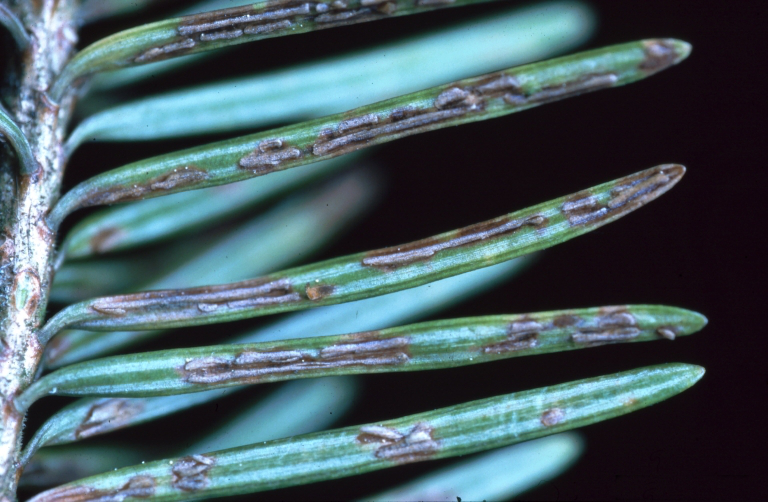Introduction
Rhabdocline needle cast is one of the most serious diseases to afflict Douglas-fir. The disease is caused by the fungal pathogens Rhabdocline pseudotsugae and Rhabdocline weirii. When infected, Rhabdocline needle cast causes needles to become discolored. Eventually, the infected needles are blighted. Blighted needles are often prematurely shed. Rhabdocline needle cast outbreaks are common, and may affect Douglas-firs in landscapes, gardens, and Christmas tree nurseries. Douglas-firs intended for use as Christmas trees can be rendered unsuitable for sale when infected by Rhabdocline needle cast. Douglas-firs in the advanced stages of infection often assume a distorted appearance. Douglas-firs that suffer from repeated defoliation tend to be infiltrated by secondary pests and other disease pathogens.
Distribution & Habitat
Rhabdocline needle cast is prevalent throughout the natural range of Douglas-fir. It has been observed across North America, Chile, Western Europe, Great Britain, New Zealand, and Australia. The disease is common in landscapes, gardens, and Christmas tree nurseries.
Hosts
Rhabdocline needle cast infects Douglas-fir. Douglas-firs originating from the Rocky Mountain states are the most prone to infection.
Disease Cycle
The fungi overwinter as lesions on previously infected Douglas-fir needles. From early to late spring, the lesions enlarge and swell, as dark brown, spherical fruiting bodies called apothecia form beneath the epidermis of the needles. During rainy conditions, the fruiting bodies burst, causing the epidermis along the length of the needles to split open. The fruiting bodies release a mass of tan to orange ascospores into the air. The spores are dispersed to the newly expanding needles by air currents and splashes of rain.
The spores germinate on the tender needles, rapidly becoming established. Once settled, the spores penetrate into the needles, where the fungi proceed to grow. Only newly developing needles can be infected by the ascospores. Most Rhabdocline needle cast infections occur around budbreak. However, sporulation may continue into early summer. By mid-summer, sporulation ceases, and the fruiting bodies turn black. The infected needles are subsequently cast. The fungi overwinter in the current year’s needles, beginning the cycle anew.
Symptoms of Infection
Symptoms of Rhabdocline needle cast generally become apparent within 1 to 2 years of infection. Yellow to brown spots or lesions develop on the upper surfaces of the current year’s needles. In time, the lesions turn reddish-brown. Infected needles may feature one or multiple lesions. When trees are heavily infected, lesions can coalesce to cover entire needles. The fruiting bodies can be observed on the lower surface of infected needles. When the fruiting bodies have exhausted their spores, the previous year’s needles will typically be shed. Severely infected trees may only retain the current year’s needles. Infected needles are generally killed within 2 to 3 years.
Management
- When planting Douglas-firs, select cultivars that exhibit an increased resistance to Rhabdocline needle cast. Rocky Mountain Douglas-firs are more vulnerable to infection than Pacific Coast Douglas-firs. Provide trees with ample spacing to promote healthy plant growth. Plant Douglas-firs in well-drained, damp soil.
- Inspect susceptible trees for disease symptoms in late winter or early spring. Conduct examinations of trees on overcast days, when needle discoloration is most visible.
- Prune out heavily infected branches or shoots. Disinfect pruning equipment in between each cut with a solution composed of nine parts water and one part bleach.
- Perform general maintenance pruning on trees to improve air circulation throughout the crown, and to encourage a rapid drying of the foliage when wet.
- When removed, infected shoots can be placed in warm water for several minutes to determine the maturity of the fruiting bodies. If mature, the fruiting bodies will release a mass of ascospores into the water.
- Cull severely infected trees to reduce the amount of inoculum present in an area, and to prevent the spread of the disease.
- Maintain trees through sound cultural practices. Ensure that trees are sufficiently watered, especially during extended periods of drought.
- Apply a layer of organic mulch around the base of vulnerable trees in spring and fall to improve the soil conditions, and to retain soil moisture. Trees can be mulched in fall once they have entered dormancy. Avoid constructing mulch piles around tree trunks. This can encourage moisture accumulation.
- Fungicidal applications can stave off Rhabdocline needle cast infections, particularly on small to medium-sized trees. Perform initial applications in spring, when the shoots have started to expand. Administer a second application 2 to 3 weeks later. If rainfall is abundant, additional applications may be necessary to achieve control.
Photo courtesy of Petr Kapitola CC-by-3.0


